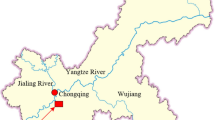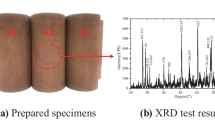Abstract
The present paper investigates the mechanical behaviour of oil sand specimens in triaxial compression tests at both ambient and elevated temperatures. The emphasis is particularly on core sample disturbance and on the multiphase/strongly heterogeneous nature of the material that introduces difficulties in achieving an objective characterization of its shear behaviour. First, the effect of sample disturbance on the behaviour of the oil sand is studied. Tests are performed on both disturbed and recompressed specimens. Recompression to large stress prior to shearing improves evaluation of the initial stiffness and associated volumetric changes of the oil sand, strongly affected by sample disturbance. A method for the correction of test results obtained from disturbed specimens is also proposed. The corrected results are in good agreement with those pertaining to recompressed specimens. Furthermore, a general classification of the tested oil sands into lean and rich in bitumen, where the former shows much softer and weaker behaviour, is considered to help in addressing the variability in sample composition. As for thermal aspects, the experimental results indicate that both strength and stiffness exhibit a limited temperature dependency. The temperature does not affect lean oil sand specimens, whereas heating considerably increases deformability of rich specimens.





















Similar content being viewed by others
References
Abdelaziz TS, Martin CD, Chalaturnyk RJ (2008) Characterization of locked sand from Northeastern Alberta. Geotech Test J 31(6):480–489
Agar JG, Morgenstern NR, Scott JD (1987) Shear strength and stress–strain behaviour of Athabasca oil sand at elevated temperatures and pressures. Can Geotech J 24(1):1–10
ASTM (2007) Annual book of ASTM standards, soil and rock, vol. 08.04. www.astm.org
ASTM (2013) Standard test method for water in petroleum products and bituminous materials by distillation, vol. 05.01
Baldi G, Hueckel T, Pellegrini R (1988) Thermal volume changes of the mineral-water system in low-porosity clay soils. Can Geotech J 25(4):807–825
Canadian Heavy Oil Association (2013) Heavy oil Latin America conference and exhibition, Mexico
Chalaturnyk RJ (1996) Geomechanics of SAGD in heavy oil reservoirs. Ph.D. thesis, University of Alberta, Edmonton, Canada
Collins PM, et al (2005) Geomechanical effects on the SAGD process. In: SPE international thermal operations and heavy oil symposium. Society of Petroleum Engineers
Czarnecki J, Radoev B, Schramm LL, Slavchev R (2005) On the nature of Athabasca oil sands. Adv Colloid Interface Sci 114:53–60
Delage P, Doan DH, Nauroy JF, Tang AM (2013) Compression behavior of Canadian oil sands. J Geotech Geoenviron Eng 139(6):969–974
Doan DH, Delage P, Nauroy JF, Tang AM, Youssef S (2012) Microstructural characterization of a Canadian oil sand. Can Geotech J 49(10):1212–1220
Duriez J, Wan R (2016) Stress in wet granular media with interfaces via homogenization and discrete element approaches. J Eng Mech. doi:10.1061/(ASCE)EM.1943-7889.0001163
Dusseault MB, Collins PM (2010) 24. Geomechanics effects in thermal processes for heavy-oil exploitation, pp 287–291. doi:10.1190/1.9781560802235.ch24
Dusseault MB (1980) Sample disturbance in Athabasca oil sand. J Can Pet Technol 19(2):85–92
Dusseault MB, Morgenstern NR (1978) Shear strength of Athabasca oil sands. Can Geotech J 15(2):216–238
Dusseault MB, Morgenstern NR (1979) Locked sands. Q J Eng Geol Hydrogeol 12(2):117–131
Goldstein J, Newbury DE, Echlin P, Joy DC, Romig AD Jr, Lyman CE, Fiori C, Lifshin E (2012) Scanning electron microscopy and X-ray microanalysis: a text for biologists, materials scientists, and geologists. Springer, Berlin
Goodman RE (1989) Introduction to rock mechanics, vol 2. Wiley, New York
Innes ED, Fear VD, et al. (1967) Canada’s first commercial tar sand development. In: 7th world petroleum congress. World petroleum congress
Kosar KM (1989) Geotechnical properties of oil sands and related strata. Ph.D. thesis, University of Alberta, Edmonton, Canada
Kosar KM, Scott JD, Morgenstern NR (1987) Testing to determine the geotechnical properties of oil sands. In: Annual technical meeting. Petroleum Society of Canada
Mohamadi M, Wan RG (2016) Strength and post-peak response of Colorado shale at high pressure and temperature. Int J Rock Mech Min Sci 84:34–46. doi:10.1016/j.ijrmms.2015.12.012. http://www.sciencedirect.com/science/article/pii/S1365160915300976
Mossop GD (1980) Geology of the Athabasca oil sands. Science 207(4427):145–152
Samieh AM, Wong RCK (1997) Deformation of Athabasca oil sand at low effective stresses under varying boundary conditions. Can Geotech J 34(6):985–990
Shah A, Fishwick R, Wood J, Leeke G, Rigby S, Greaves M (2010) A review of novel techniques for heavy oil and bitumen extraction and upgrading. Energy Environ Sci 3:700–714. doi:10.1039/B918960B
Sulem J, Ouffroukh H (2006) Shear banding in drained and undrained triaxial tests on a saturated sandstone: porosity and permeability evolution. Int J Rock Mech Min Sci 43(2):292–310
Takamura K (1982) Microscopic structure of Athabasca oil sand. Can J Chem Eng 60(4):538–545
Wong RCK (1999) Mobilized strength components of Athabasca oil sand in triaxial compression. Can Geotech J 36(4):718–735
Wong RCK, Barr WE, Kry PR (1993) Stress–strain response of cold lake oil sands. Can Geotech J 30(2):220–235
Acknowledgements
This work was funded by the Natural Sciences and Engineering Research Council of Canada and Foundation Computer Modelling Group.
Author information
Authors and Affiliations
Corresponding author
Rights and permissions
About this article
Cite this article
Piotrowska, E., Mohamadi, M. & Wan, R. Effects of sample disturbance and heterogeneity on the triaxial behaviour of a Canadian oil sand at ambient and high temperatures. Acta Geotech. 13, 457–471 (2018). https://doi.org/10.1007/s11440-017-0575-8
Received:
Accepted:
Published:
Issue Date:
DOI: https://doi.org/10.1007/s11440-017-0575-8




